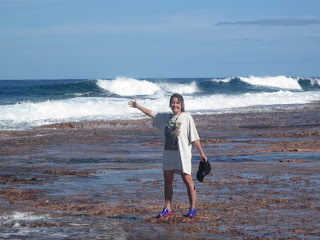Question: What looks
tropical, feels tropical, but isn't tropical?
Answer: Minerva Reef
Lying some 60 miles south of the Tropic of Capricorn, North
Minerva Reef is just barely subtropical--and at about 2/3 of the distance from New Zealand to either Tonga
or Fiji ,
North and South Minerva Reefs provide convenient stopovers to break up that
1100 mile trip. North Minerva is particularly popular, with a clear pass into
the lagoon and few underwater hazards once inside.
 |
| North Minerva Reef from less than a mile away; it's unsafe to approach without accurate GPS readings--and sharp eyes--since it is barely visible |
 |
| Going through the pass; it looks nerve-wracking with breaking waves at the sides, but near slack tides the center is clear |
It's a sunken volcanic cone, almost perfectly circular and
about 2 miles across; inside, protected by the reef, the water is usually
relatively calm. Parts of the reef get exposed at low tide, but most of the
time all that's visible is a huge surround of breaking waves, accompanied by
the constant rumble of surf. More interesting is the way it feels: how bizarre,
to be anchored in the middle of the ocean!
Question: What does
one do in the middle of nowhere for a week?
Answers:
Putter around doing
projects from the low priority list
 |
| Installing a cockpit light; not a necessary item, but enhances evening activities while anchored |
Read something besides
manuals and guidebooks. I finished and Art started Ellen MacArthur's
autobiography, "Taking on the World"--the young Briton who raced
around the globe single-handed when she was only 24. Such courage, such
stamina, such passion! An inspiration to all, not just sailors.
Play Bach on my
violin...
Spend the day in
stitches
 |
| Adding webbing to reinforce a corner of the genoa |
 |
| Replacing a zipper for one of the cockpit enclosure panels |
Count the boats in the
Minerva Reef Yacht Club
Yes, it's a joke, since there's absolutely nothing
there--but enough boats transit every year that there is a MYRC t-shirt
available in New Zealand !
There was just 1 other boat in the lagoon when we arrived,
and 4 when we left--but at its peak, there were 32 boats anchored inside (due
in part to weather changes, and the presence of not one but two groups of boats
traveling together to Fiji ).
Some boats we knew, some we didn't, but there was definitely a feeling of
community.
 |
| "Hey! Who moved the clubhouse?!" |
Walk on the reef at
low tide
 |
| Oceanfront property |
 |
| 50' of water inside the lagoon, and over 1600' outside |
 |
| Wading through the warm pools we found darting fish, sea slugs, anemones, sea urchins, and large blue-lipped oysters |
 |
| One of our Best Days Ever |
Another day we planned to go back, but couldn't: a 17' ocean swell
arrived from a strong system in New
Zealand , bringing crashing surf that made
the edge inaccessible (and the lagoon water quite choppy!).
Change anchorage
locations when the wind changes
Sailors don't like to be anchored on a lee shore; if the
anchor drags--infrequent, but possible--the boat will end up on the rocks.
Prudent sailors keep themselves out of that situation by anchoring "close
to the wind" whenever possible.
 |
| View from Anchorage #1 |
 |
| View from Anchorage #2 (all just looks like water, doesn't it?) |
 |
| View from Anchorage #3 (definitely more wind & wave action) |
Watch the world turn
 |
| Sunset (or was this sunrise?); the edge of the reef is barely visible as a large wave on the horizon |
We felt what it was like not to go somewhere, but to be
somewhere. Living for a week in the middle of the ocean, Minerva Reef was a
unique and precious experience.




